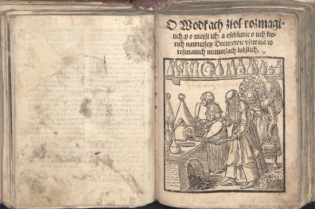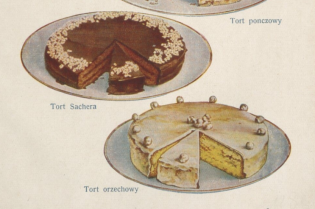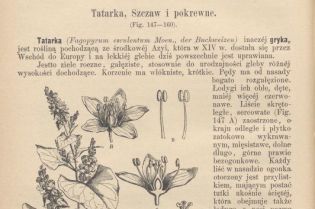Chickpeas and artichokes - things that used to be grown in Krakow
Monasteries, in particular the Benedictines from Tyniec and Cistercians from Mogiła, had a huge impact on the development of agriculture and horticulture in Krakow.
The monks brought with them new plants and educated the residents of surrounding villages. Monastic gardens were used to cultivate vegetables, medicinal herbs, trees, shrubs and ornamental plants. Some gardens (such as the one in Tyniec) included vineyards as well.
Archaeological work shows that in the Middle Ages gardens and small plots in Krakow and around the city were used to "cultivate mainly vegetables and herbs such as wild cabbage (Brassica oleracea), rapeseed (Brassica napus), field mustard (Brassica rapa), onion (Allium cepa), dill (Anethum graveolens), peas (Pisum sativum) and broad beans (Vicia faba). (...) Cereal plants were transported from fields located in the environs of the city. The most common grain found on the site was proso millet (Panicum miliaceum) which could mean that it was the most widely grown. Commonly grown crops included rye (Secale cereale), barley (Hordeum vulgare) and oats (Avena sativa). Other commonly cultivated cereal plants were purple amaranth (Amaranthus lividus), foxtail millet (Setaria italica) and einkorn wheat (Triticum monococcum). Marcin Woch also emphasises that the research material contained quite a lot of fig remnants. This may mean that they were either commonly imported and popular among medieval burghers or that people actually tried to cultivate them.
Bona Sforza's gardens and vineyard at Wawel
The royal accounts tell us that as early as in the 16th century there were royal gardens, a vineyard, and an aviary at Wawel. The accounts also reveal that carpentry and gardening works in Wawel’s vineyard took place since the 1530s. Some information about the vineyard also appears in documents from the 17th century. It remains unknown when and why it was destroyed. Vines made a comeback to Wawel in 1827. Antoni Bukowski, a city gardener, designed both a vineyard and a peach orchard. The vineyard at Wawel was established on municipal ground next to the castle walls. Unfortunately, the vines were removed 24 years later when an army barracks was built on the hill. A few years ago, as a symbolic reference to wine-growing, a plot near Wawel tourist trail was planted with cold-hardy grape varieties: Concord, Ontario, Alwood and Cascade.
Queen Bona Sforza also owned a garden in Zwierzyniec. Mirosław Frančić claims that it was established on land donated to the king by the Norbertine nuns. Marcin of Urzędów wrote in "Herbarz" that Bona had chickpeas sown in Zwierzyniec.
Artichokes from Łobzów
Today's Łobzów and Krowodrza districts used to be farmlands with very fertile soil. "The fields around these villages (...) make up a single vegetable garden and it is so well cultivated, so efficiently governed that it can be regarded as exemplary (...)". Produce from these gardens, in particular the famous artichokes, apparently arrived in Warsaw, Berlin and Wrocław at the end of the 18th century. Kolberg also wrote about these artichokes from Krakow: "they were also famous Krakow products such as: prints, carriages, sleds, horse collars, scythes, sabres, calendars, marbles, beer, groats (fine buckwheat), vegetables (artichokes), bread (prądnicki), bread rolls, cakes, kukiołka rolls".
Sources:
Marcin W. Woch „Rośliny towarzyszące człowiekowi w średniowiecznym Krakowie”, w: Edukacja Biologiczna i Środowiskowa” 3/2013
S. Krzyżanowski za: Barbara Stępniewska „Ogrody Krakowa w okresie średniowiecza i renesansu”, Rocznik Krakowski, t. XLIV, Kraków 1973
Dorota Nalepka „Renesansowe Ogrody Królewskie na Wawelu. Palinologiczne badania ogrodów na górnym tarasie”, Architektura. Czasopismo Techniczne, Wydawnictwo Politechniki Krakowskiej 6-A/2012. vol. 19: s. 39-43
https://polona.pl/item/herbarz-polski-to-iest-o-przyrodzeniv-ziol-y-drzew-rozmaitych-ksiegi-dwoie-doctora,MTE2NTM2NzM/239/#item
Ambroży Grabowski za: Barbara Stępniewska „Ogrody Krakowa w okresie średniowiecza i renesansu”, Rocznik Krakowski, t. XLIV, Kraków 1973
Józef Mączyński za „Szkice z dziejów Krakowa” red. J. Bieniarzówna
https://polona.pl/item/historyczny-opis-miasta-krakowa-i-iego-okolic,MTMwNjU2OA/37/#item
„Cudzoziemcy o Polsce. Relacje i opinie” oprac. J. Gintel, t. 2, Kraków 1971, s. 155
Oskar Kolberg, „Lud. Jego zwyczaje…”, t. 8, Kraków 1871










